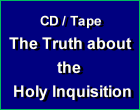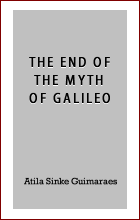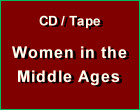Movie Review
 |
 |
 |
 |
 |
 |
 |
The Black Legend of the Inquisition
Put to Rest
reviewed by Phillip Mericle
In the years I’ve been a Catholic I’ve noticed that one subject frequently brought up about the “evils” of the Church is the “infamy” of the Spanish Inquisition. How many movies and television shows have we seen that depict the Inquisition of Spain as a bloodthirsty and tyrannical tribunal determined to cow the world with fear as it slaughters without concern for law or evidence?
Many Catholics I’ve met even apologize for the Spanish Inquisition, as if it were a black mark in the History of the Church that must be swept under the carpet, like the Crusades. Protestants cite it as the cruel reality of Roman tyranny, while atheists sneer at it as the inevitable product of religious belief.
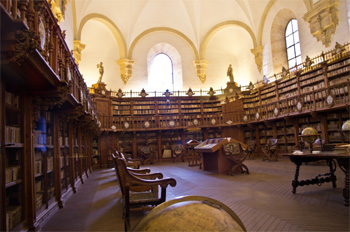 It may interest our readers to know, however, that the ground upon which such anti-Catholic arguments rest has, in fact, no basis in historical evidence. Even so, I was surprised to see that none other than the BBC – British Broadcasting Corporation – was the agency that attempted to bring the truth about the Black Myth to light.
It may interest our readers to know, however, that the ground upon which such anti-Catholic arguments rest has, in fact, no basis in historical evidence. Even so, I was surprised to see that none other than the BBC – British Broadcasting Corporation – was the agency that attempted to bring the truth about the Black Myth to light.
This 46-minute film, produced in 1994, outlines the history and facts of the Spanish Inquisition, basing its information on a systematic study of the private official records of the Inquisition. Although the archives are massive and exhaustive, even the beginning phases of research showed a very different image than that of a cruel and sadistic Catholic tribunal. Instead, what we get is an image of one of the fairest and most levelheaded tribunals of Europe. In this film the Black Myth of the Spanish Inquisition is denounced by the disinterested third party of the BBC.
The argument that this film makes rests on several points. First, the archives that were meticulously kept by the Inquisition were intended only for the Inquisition's use. Thus it cannot be said that they were colored to present a favorable image for the public eye.
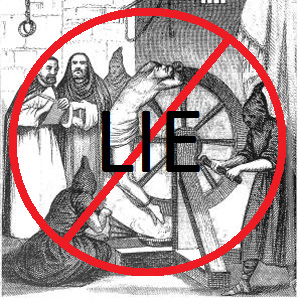 But what of the information itself? The data derived from these archives show us a tribunal that was fair, level-headed, restrained, reluctant to resort to execution and even more reluctant to resort to torture. Many forms of torture, such as the wheel and iron maiden, were never used by the Inquisition at all.
But what of the information itself? The data derived from these archives show us a tribunal that was fair, level-headed, restrained, reluctant to resort to execution and even more reluctant to resort to torture. Many forms of torture, such as the wheel and iron maiden, were never used by the Inquisition at all.
Inquisitors came from the ranks of university lawyers and based their inquiries on law. According to the BBC’s research, one district of the Inquisition would not even consider cases where women were accused of witchcraft. Such accusations were so lacking in solid evidence that the Inquisition declared the inquiries to be the result of superstition.
Inquisition courts and prisons were the envy of the land, and criminals would actually blaspheme in secular courts in the hope that they would be brought before the Holy Inquisition instead. The sentences of the Spanish Inquisition were much more lenient than those of the courts of France, England, the Holy Roman Empire, and other European countries.
The Inquisition did not have immense power in the temporal sphere, as the Protestants would pretend. In the major cities of Spain, the aristocracy, secular institutions and even other Church institutions all competed for power and royal favor, leaving the Inquisition with little influence. Their weight was even less in the countryside where the territories were vast and the peasants uncooperative.
In an era where travel was difficult two inquisitors could be responsible for thousands of square miles. Additionally, the peasantry were so ignorant that some priests would simply instruct their parishioners to respond to the inquisition with silence to prevent them from saying something superstitious that might oblige an investigation. For the university educated inquisitors, questioning such rustic and uncooperative people was an unpleasant waste of time, and many Inquisitors shirked their duty rather than make such fruitless visits.
But how did the Black Myth of an unjust and cruel Spanish Inquisition spread? Where did it originate and how?
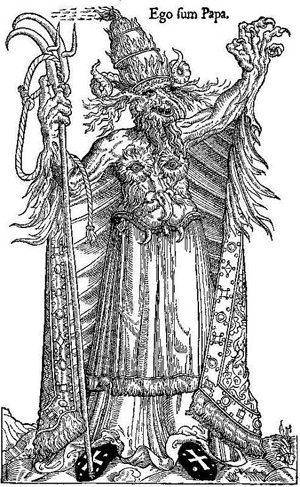 The historical information presented in this documentary points straight to the Protestants. Defeated on the battlefield by the Catholic armies of the Habsburg Empire, the Protestants resorted to the printing press to spread calumnies against the Church, focusing on Spain as the superpower of the day in much the same way that the United States is viewed as the epitome of Western evil by many Muslims today.
The historical information presented in this documentary points straight to the Protestants. Defeated on the battlefield by the Catholic armies of the Habsburg Empire, the Protestants resorted to the printing press to spread calumnies against the Church, focusing on Spain as the superpower of the day in much the same way that the United States is viewed as the epitome of Western evil by many Muslims today.
The Holy Spanish Inquisition, not to mention the personal character of the Spanish Kings, became the target of the Protestant pen. The Catholic countries, loathe to resort to such low combat as calumny and printed lies, did not respond adequately to what historians are now discovering to be the forgeries and falsified evidence left by resentful Protestants. Fabrications about the supposed torture and cruelties of the Inquisition spread like wildfire among those ready to pounce at the slightest pretense to defame Spain or Holy Mother Church. It is this Black Myth that continues to be spread by partisans of the French Revolution, Freemasons, and Hollywood film makers today. This is why to this day those initial falsities continue to live in the public’s mind.
Although this video adopts a secular perspective, such as its presumption that Devil worship and witchcraft were bogus from the start or when it puts the Catholic military in a bad light, I believe it offers a predominantly unbiased response to the many false accusations leveled at the History of the Catholic Church. I encourage our readers to watch and spread this video and information to those they know, thus helping in at least some small way to repair the damage done to the reputation of the Church and her holy institutions.
The BBC video can be watched here.

Many Catholics I’ve met even apologize for the Spanish Inquisition, as if it were a black mark in the History of the Church that must be swept under the carpet, like the Crusades. Protestants cite it as the cruel reality of Roman tyranny, while atheists sneer at it as the inevitable product of religious belief.

The impartial analysis of Inquisition archives, like the one in Salamanca above, destroys the Black Myth
This 46-minute film, produced in 1994, outlines the history and facts of the Spanish Inquisition, basing its information on a systematic study of the private official records of the Inquisition. Although the archives are massive and exhaustive, even the beginning phases of research showed a very different image than that of a cruel and sadistic Catholic tribunal. Instead, what we get is an image of one of the fairest and most levelheaded tribunals of Europe. In this film the Black Myth of the Spanish Inquisition is denounced by the disinterested third party of the BBC.
The argument that this film makes rests on several points. First, the archives that were meticulously kept by the Inquisition were intended only for the Inquisition's use. Thus it cannot be said that they were colored to present a favorable image for the public eye.

The Inquisition rule book strictly forbade the forms of torture Protestants pretend were applied
Inquisitors came from the ranks of university lawyers and based their inquiries on law. According to the BBC’s research, one district of the Inquisition would not even consider cases where women were accused of witchcraft. Such accusations were so lacking in solid evidence that the Inquisition declared the inquiries to be the result of superstition.
Inquisition courts and prisons were the envy of the land, and criminals would actually blaspheme in secular courts in the hope that they would be brought before the Holy Inquisition instead. The sentences of the Spanish Inquisition were much more lenient than those of the courts of France, England, the Holy Roman Empire, and other European countries.
The Inquisition did not have immense power in the temporal sphere, as the Protestants would pretend. In the major cities of Spain, the aristocracy, secular institutions and even other Church institutions all competed for power and royal favor, leaving the Inquisition with little influence. Their weight was even less in the countryside where the territories were vast and the peasants uncooperative.
In an era where travel was difficult two inquisitors could be responsible for thousands of square miles. Additionally, the peasantry were so ignorant that some priests would simply instruct their parishioners to respond to the inquisition with silence to prevent them from saying something superstitious that might oblige an investigation. For the university educated inquisitors, questioning such rustic and uncooperative people was an unpleasant waste of time, and many Inquisitors shirked their duty rather than make such fruitless visits.
But how did the Black Myth of an unjust and cruel Spanish Inquisition spread? Where did it originate and how?

Protestants resorted to calumnies spread by the printing press after being defeated
The Holy Spanish Inquisition, not to mention the personal character of the Spanish Kings, became the target of the Protestant pen. The Catholic countries, loathe to resort to such low combat as calumny and printed lies, did not respond adequately to what historians are now discovering to be the forgeries and falsified evidence left by resentful Protestants. Fabrications about the supposed torture and cruelties of the Inquisition spread like wildfire among those ready to pounce at the slightest pretense to defame Spain or Holy Mother Church. It is this Black Myth that continues to be spread by partisans of the French Revolution, Freemasons, and Hollywood film makers today. This is why to this day those initial falsities continue to live in the public’s mind.
Although this video adopts a secular perspective, such as its presumption that Devil worship and witchcraft were bogus from the start or when it puts the Catholic military in a bad light, I believe it offers a predominantly unbiased response to the many false accusations leveled at the History of the Catholic Church. I encourage our readers to watch and spread this video and information to those they know, thus helping in at least some small way to repair the damage done to the reputation of the Church and her holy institutions.
The BBC video can be watched here.

Posted January 30, 2015
______________________
______________________



